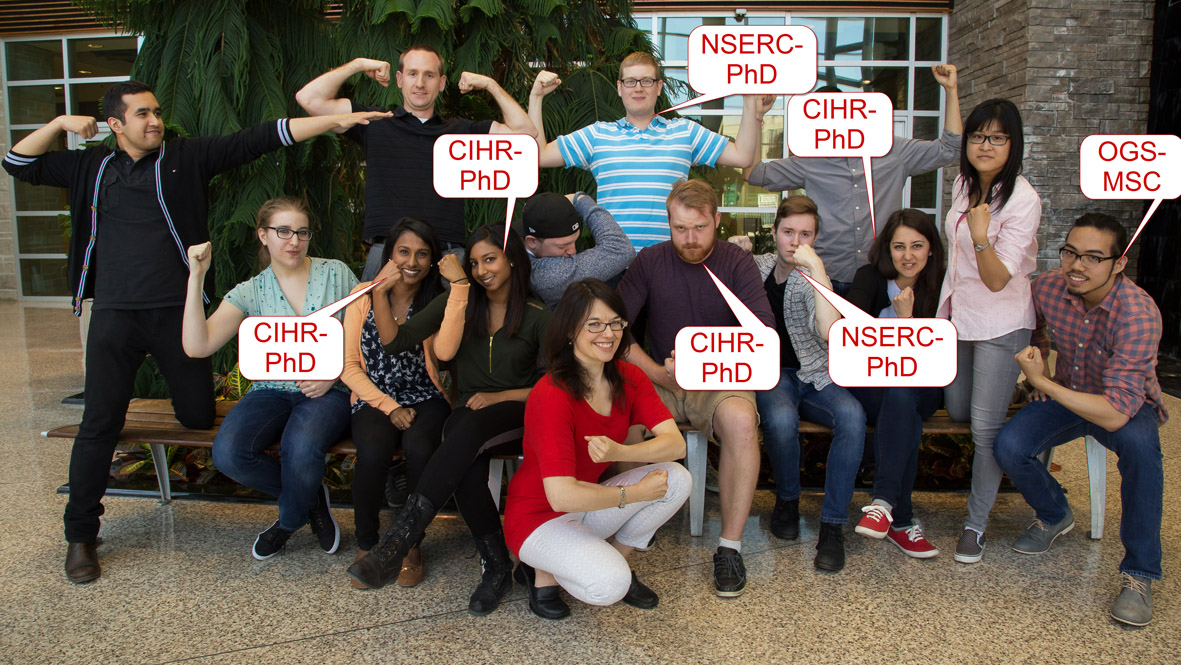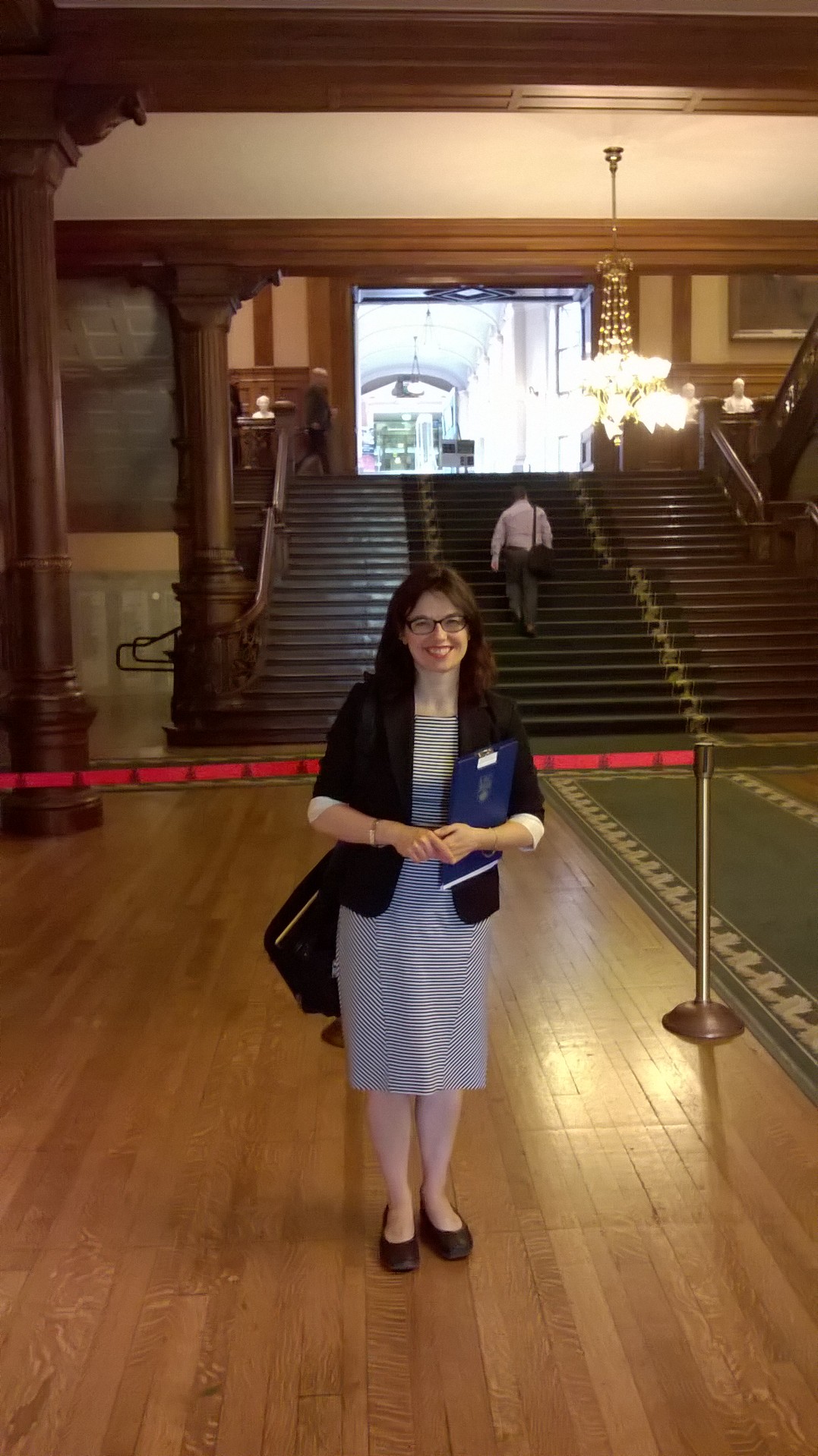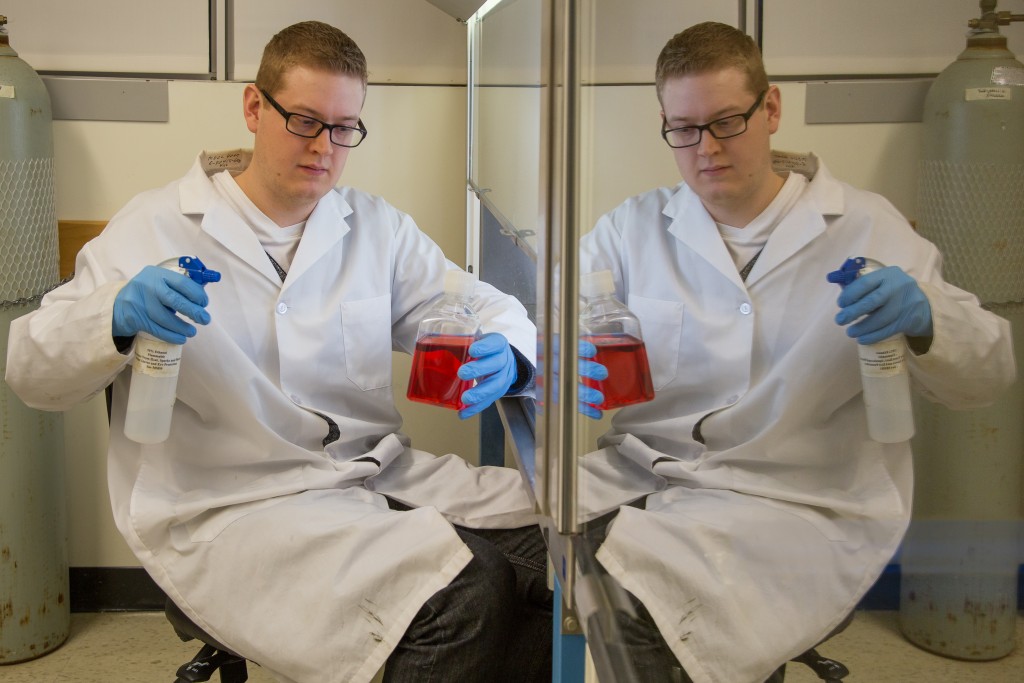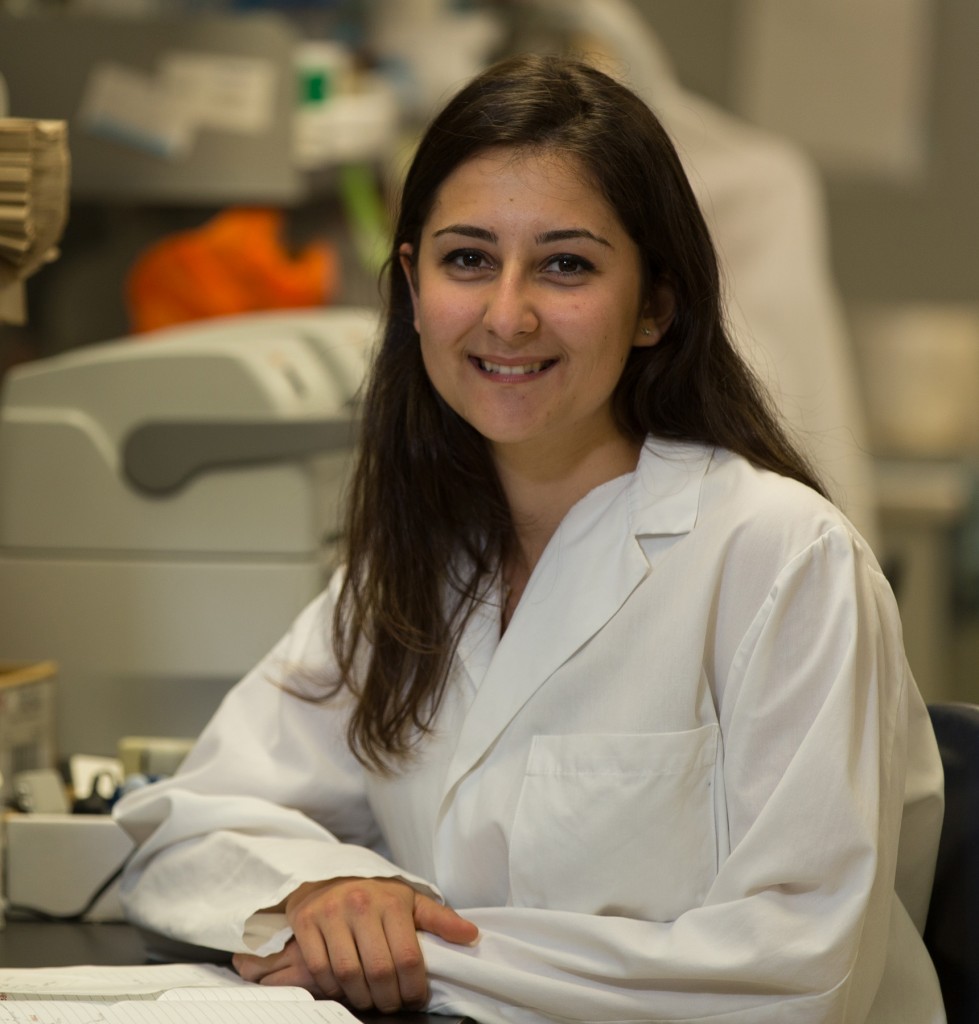Who’s got the strongest lab at McMaster? I do! We’ve had a great run of success at the Bowdish lab with fully all of our students receiving prestigious scholarships! And that’s not to mention our other successes such as our summer scholarship winners (Jason Fan – IIDR), our students who got their degree and moved on to great things (Dr. Fan Fei – manager of Mass Spec facility, Dr. Mike Dorrington – PDF at the NIH), and our PDF, Dr. Chris Verschoor who got a faculty position!
Author Archives: Dr. Dawn M. E. Bowdish
Dr Bowdish gives a deputation at Queen’s Park in support of Bill 41, The Lung Health Act.
The Bowdish lab has been working with the Ontario Lung Association to encourage politicians to support Bill #41 – The Lung Health Act. You may not be aware that of all the common chronic diseases (e.g. cardiovascular, diabetes), lung disease is the only one that doesn’t have a dedicated action plan. Because of this rates of lung disease are higher then they need to be and many “best practices” for treating or preventing lung disease are not in place, compromising the health of many Ontarians and increasing health care costs. For this reason MPP Kathryn McGarry put forth a private members bill to create a Lung Health Act for Ontario. Bill 41 would entail establishing a Lung Health Advisory Council to make recommendations to the Minister of Health and Long-Term Care on lung health issues; and requiring the Minister to develop and implement an Ontario Lung Health Action Plan respecting research, prevention, diagnosis and treatment of lung disease. In Novemver our lab attended a provincial lobby day where we discussed the importance of this bill with politicians. On June 6th Dawn gave a deputation to the Committee on Social Policy on why this Bill would be of particular importance to older adults.
To see the entire 4 hours of deputations (ouch!) click here.
To read more of the FAQ around the Lung Health Act click here.
To read more about the Ontario Lung Association’s draft Lung Health Action Plan, click here. (Bonus – you can donate to the Lung Association to support this work via that link too!).
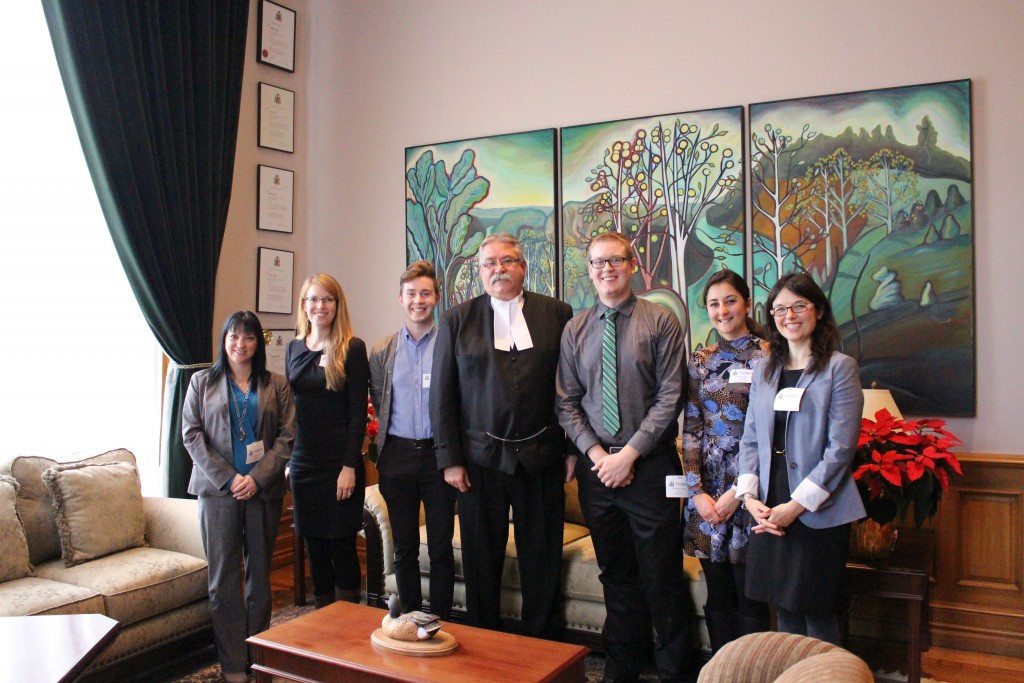
Tammy Villeneuve (OLA), Andrea Kellner, Justin Boyle, MPP Dave Levac, Kyle Novakowski, Dessi Loukov and Dr. Dawn Bowdish meet to discuss the Lung Health Act.
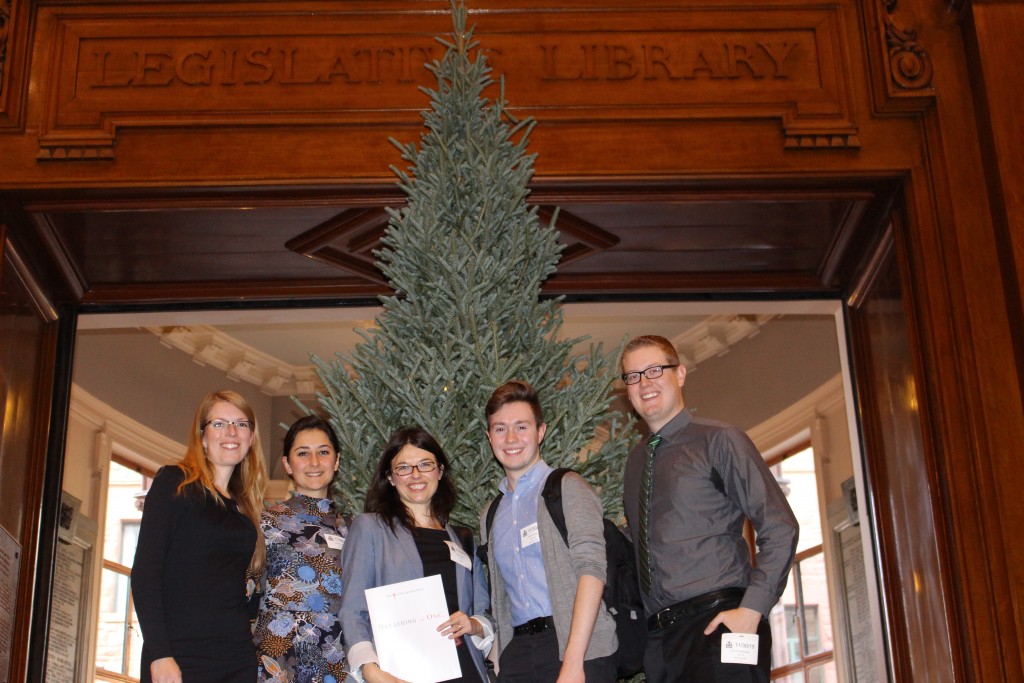
The Bowdish lab attends lobby day in November 2015 to discuss the importance of the Lung Health Act with MPPs.
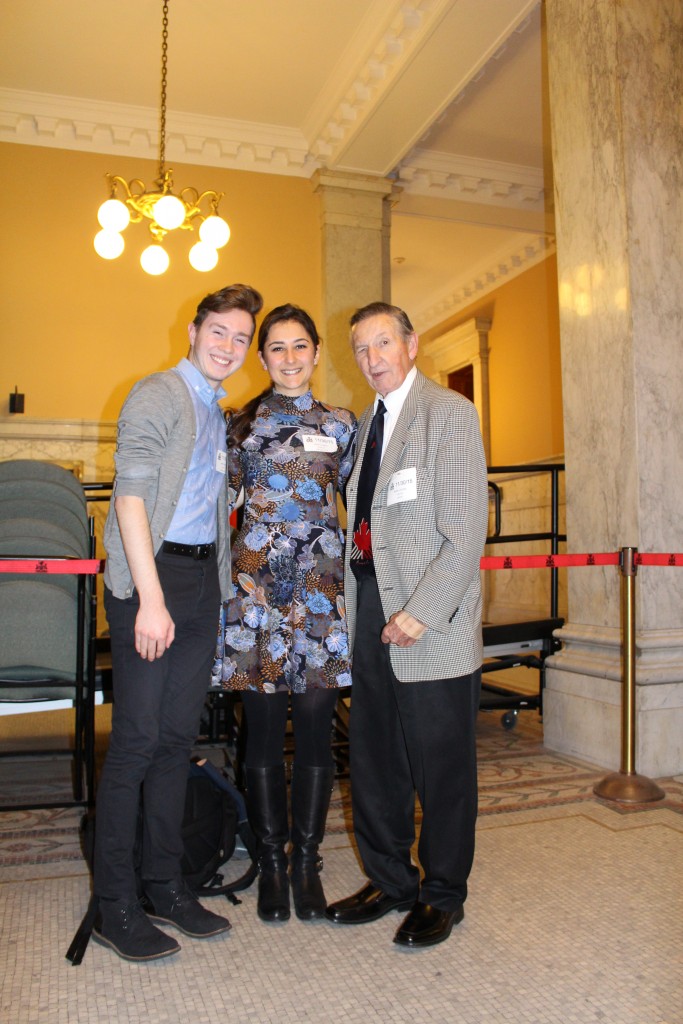
Walter Gretzky supports the Lung Health Act – you should too! (with Justin Boyle & Dessi Loukov)
Publication: Tumor necrosis factor drives increased splenic monopoiesis in old mice

PhD student Dessi Loukov in the lab of Dr. Dawn Bowdish, recently published a study showing that splenomegaly in old mice is a result of extramedullary hematopoiesis, and that this increased monopoiesis is driven by age-associated increase in TNF. The study compared changes in the microarchitecture and composition of the spleen in old and young mice and found that in old mice, there was an increase in the size and cellularity of the red pulp (the site of hematopoiesis of myeloid precursors). To study the role of TNF in the development of extramedullary hematopoiesis, they used TNF KO mice and found that these mice did not have increased extramedullary monopoiesis. Furthermore, they demonstrated that increased splenic myelopoiesis was a result of the aging microenvironment. This work suggests that strategies which aim to decrease the inflammatory microenvironment that comes with aging, would be effective in reducing inflammatory diseases propagated by cells of the myeloid lineage. Read More
Congratulations to Kyle Novakowski for passing his comprehensive exam!
Publication: Streptococcus pneumoniae Colonization Disrupts the Microbial Community within the Upper Respiratory Tract of Aging Mice
Colonization of Streptococcus pneumoniae within the upper respiratory tract (URT) of elderly individuals is a major concern, as it often results in the development of pneumonia, which can be deadly in this population. A study published by MIRC Masters’ student Netusha Thevaranjan, under the supervision of Dr. Dawn Bowdish, examined how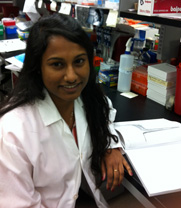 aging can change the composition of the respiratory microbial community and consequently, impact bacterial colonization. Using a mouse model of pneumococcal colonization, the study characterized the composition of the URT microbiota in young, middle-aged, and old mice in both the naïve state, and throughout the course of nasopharyngeal colonization with S. pneumoniae. It was shown that the composition of the URT microbiota differs with age, and that colonization with S. pneumoniae in older mice disrupted pre-existing microbial communities.
aging can change the composition of the respiratory microbial community and consequently, impact bacterial colonization. Using a mouse model of pneumococcal colonization, the study characterized the composition of the URT microbiota in young, middle-aged, and old mice in both the naïve state, and throughout the course of nasopharyngeal colonization with S. pneumoniae. It was shown that the composition of the URT microbiota differs with age, and that colonization with S. pneumoniae in older mice disrupted pre-existing microbial communities.
Furthermore, the study demonstrated that there were several interspecies interactions between S. pneumoniae and resident microbes. In particular,Streptococcus interacted competitively with Staphylococcus and synergistically with Haemophilus. This work provides insight into how aging influences bacterial colonization, and understanding the relationship between these two factors can help create strategies to protect the elderly from age-associated infections and disease. Read More
New protocol: Culturing the human nasopharyngeal cell line, Detroit 562.
See our “Protocol” page for more cell culture protocols.
![]() Culturing, Maintaining and Seeding the nasopharyngeal cell line Detroit 562
Culturing, Maintaining and Seeding the nasopharyngeal cell line Detroit 562
- This human derived nasopharyngeal carcinoma cell line maintains many of the properties of nasopharyngeal epithelial cells.
Publication: A naturally occurring transcript variant of MARCO reveals the SRCR domain is critical for function
Macrophages play a critical role in innate immunity by detecting, engulfing and destroying pathogenic bacteria and alerting neighbouring immune cells to join the fight against infection. They have many different receptors on their cell surface that allow them to carry out these important processes. A particular group of receptors called Scavenger Receptors are vital to this response. A recent study published in Immunology and Cell Biology by PhD student Kyle Novakowski from the laboratory of Dr. Dawn Bowdish has uncovered a mechanism by which a specific scavenger receptor contributes to macrophage-specific antibacterial immunity.
Scavenger Receptors are evolutionarily ancient and have evolved to recognize a wide array of pathogens by detecting ligands that are common across many pathogenic organisms. A particularly important Scavenger Receptor is Macrophage Receptor with Collagenous Structure, or MARCO. MARCO has been shown to significantly contribute to the clearance of Streptococcus pneumoniae colonization of the nose and in models of pneumococcal pneumonia. The NSERC-funded study took a unique approach to functionally characterizing how MARCO contributes to innate immunity by studying a naturally-occurring variant of the receptor. The study highlighted the importance of a particular domain of the receptor that is required for macrophages to bind and internalize ligands. The study also showed that the domain is necessary to enhance the pro-inflammatory response to pathogenic Streptococcus pneumoniae and can enhance cellular adhesion; both vital to proper macrophage functions.
To read the article, please click here.
View the Bowdish lab’s entry to #MacArtOfResearch contest here (courtesy of Kyle Novakowski)
Inflammation causes white blood cells to drastically change shape. This cell is viewed at 8000x! #MacArtofResearch pic.twitter.com/lbWllnnDK6
— MacArtofResearch (@McArtofResearch) April 2, 2016
Congratulations to Dessi Loukov for passing her PhD comprehensive exam!
Vote/like our video highlighting our NSERC funded research!
The Bowdish lab is thrilled to participate in NSERC’s “Science, Action!” video contest. An undergraduate team of videographers (Yung Lee, Karanbir Brar, and Tony Chen) filmed our lab discussing our NSERC funded work on discovering the evolutionary origins of phagocytosis. Please “like” and share our video to help us move on to the next level of the competition.
Our NSERC funding has been integral to the lab. This was one of the first grants that got the lab up and running and to date we have had 5 NSERC funded graduate students and 10 undergraduate students including 3 NSERC Undergraduate Summer Research Assistants in the lab. This funding has also been instrumental in developing new techniques, technologies and collaborations that have extended our research capacity.
What are we studying with our NSERC funded research?
Our NSERC Discovery Grant entitled “Uncovering mechanisms of phagocytosis by class A scavenger receptors” allows us to use bioinformatics and molecular biology to understand the very origins of immunity.
Our lab studies macrophages, which are sentinel cells of the innate immune response. They patrol the body and engulf damaged tissues or pathogens and destroy them. This Pac-man like ability to eat microbes is called “phagocytosis”. We study a particular class of receptors that macrophages use to phagocytose called the scavenger receptors.
Phagocytosis is an ancient process that is central to defence and nutrient acquisition in single-celled organisms and embryonic development, clearance of modified host proteins and innate immunity in multi-cellular organisms. During phagocytosis a phenomenal amount of information is transmitted to the cell including the size and shape of the particle, its composition, and potential toxicity. How this information is transmitted is not really understood but is the focus of our work.
All the major discoveries in immunology (e.g. toll like receptors, intracellular sensors, signalling pathways) began with studies in comparative or evolutionary biology and my program of research continues this tradition. Indeed, the process of phagocytosis is believed to be the prototype function of the immune system as acquisition of nutrients developed into a mechanism of self- versus non-self recognition. The process of uptake is so ancient that it must have occurred prior to or in conjunction with the expression of protein receptors on the surface of the cell. The scavenger receptors, being primitive but effective uptake receptors may rely on membrane dynamics and lipid interactions more than their more evolutionarily recent counterparts (e.g. Fc receptors). We use bioinformatics to study the genomes of ancient and modern animals to study how the scavenger receptors change over time. Parts of the scavenger receptor gene or protein that haven’t changed over time, are likely very important for function. We use molecular biology to uncover how these particular regions of the protein work. Studying these processes will uncover novel mechanisms of signalling and contribute to our understanding of the cell biology of endocytosis and phagocytosis, which are processes integral to embryonic development, immunity, homeostasis, implant recognition and adhesion and consequently essential to many fields of biology.
Check out the other videos of the “Science, Action!” video contest here.
http://www.nserc-crsng.gc.ca/ScienceAction/index_eng.asp
To read more about our NSERC funded work click here.


